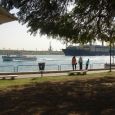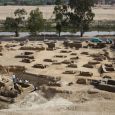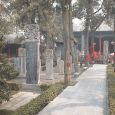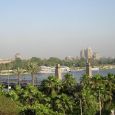Ismailia
Advertisement
By Train
Trains in the canal zone are slow and inefficient. If you must use them, 2nd-class trains to Cairo (four to five hours, eight daily) cost E£11 to E£14. To Port Said, there are six trains per day (E£3 to E£7) in 2nd class. There are also frequent trains to Suez (E£1 to E£3 in 3rd class only).
By Bus
Ismailia’s bus station is about 3km northwest of the old quarter; taxis to the town centre cost from E£3 to E£5. East Delta Bus Co (332 1513) has buses to Cairo (E£7.25, 2½ hours) every half-hour between 6am and 8pm. Buses to Alexandria (E£25, five hours) leave at 7am, 10.30am and 2.30pm. Buses to Port Said (E£4 to E£6, two hours) and Suez (E£4 to E£6, 1½ hours) depart every hour from 7am to 6pm.
There are also hourly buses to Al-Arish (E£10 to E£12, three to four hours) between 8.30am and 5.30pm. Buses to Sharm el-Sheikh (E£30 to E£35, six hours) leave frequently throughout the morning, starting at 6.30am. Afternoon and evening departures include those at noon, 2.30pm, 5.30pm, 10pm and 11pm, with the 2.30pm and 11pm services going on to Dahab (E£45 to E£50, eight hours).
Garden of the Stelae
In the Garden of the Stelae are a number of large stelae from Tell el-Maskhuta. Of particular interest are a granite stela in the name of Ramesses II with a relief of the King offering an image of Maat, goddess of truth, to the falcon headed Re-Harakhty and another relief of the King before Atum on the back; Ramesses II between the gods Khepri and Atum; recumbent sphinxes, including one dedicated by Ramesses II to Atum and Harmachis; a fragment of a chapel dedicated by Ramesses II in the Temple of Teliel-Maskhuta; the black granite lid of a sacrophagus belonging to a high palace official from Tell el-Maskhuta; and a granite chapel from El-Arish with an inscription relating to the rule of the gods on earth.
Ismailia Canal
The Ismailia Canal or Freshwater Canal, constructed in 1858-63 to supply the villages on the Suez Canal with drinking water and enlarged in 1876, is to a large extent a modern replacement of an ancient canal dating from the Middle Kingdom which ran east from the Nile, watered the Biblical land of Goshen with its various branches and flowed into the Bitter Lakes, making them sweet (as Strabo tells us) and connecting them with the Red Sea.
The Biblical Land of Goshen lay to the south of the Ismailia Canal, roughly in the triangular area between El-Zagazig, Bilbeis and Abu Hammad. It is first mentioned in Genesis 45: 10, when Pharaoh says to Joseph: "And thou shalt dwell in the Land of Goshen, and thou shalt be near unto me, thou, and thy children, and thy children's children, and thy flocks, and thy herds, and all that thou hast." There are further references to Goshen in Genesis 46: 28-29 and 47: 1, 6 and 27; and Exodus 1: 11 names the cities in which the Israelites were compelled to work for Pharaoh: "Therefore they did set over them taskmasters to afflict them with their burdens. And they built for Pharaoh treasure cities, Pithom and Raamses." The Land of Goshen was part of the old Egyptian province of Arabia. Its capital, Persopt (Greek Pharcusa) was discovered by the Swiss archeologist E. Naville at Saft el-Hina, near Suwa. The remains have now completely disappeared, but a few ancient stones may be seen built into the walls of modern houses.
Tell el-Maskhuta
Some 14mi/22km west of Ismailia, in the Wadi Tumilat, is the Tell el-Maskhuta, the site of the Egyptian stronghold of Tiyeku, which was excavated by E. Naville in 1883. This is believed by many authorities to be the Biblical Pithom (Egyptian Per-Atum, "House of Atum"), one of the two cities which the Israelites were compelled to build for their Egyptian taskmasters (Exodus 1: 11), which became the capital of the eighth nome of Lower Egypt. The store rooms found near the temple, deep rectangular chambers without doors into which the grain was poured from above, are thought to date from the time of Ramesses II and may possibly be the "treasure cities" (storehouses) mentioned in the Bible. Alternatively it has been suggested that these structures were part of a fort.
Midan el-Gumhuriya
A busy shopping street runs southeast from the railroad station by way of the Midan el-Gumhuriya (gardens) to the Mohammed Ali Quay.
October - March





